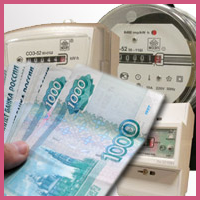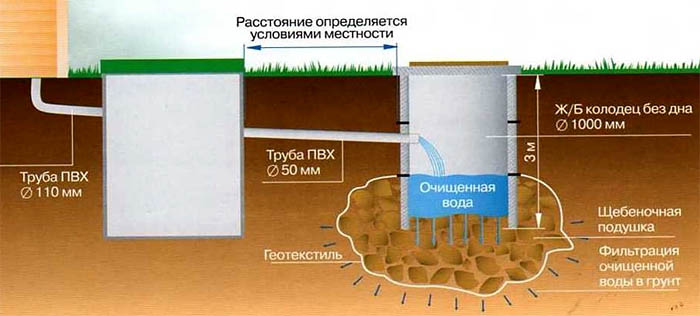In most cases, the owners of suburban areas are forced to equip all communications from scratch. Outside settlements, as a rule, there is no possibility of connecting to central highways (except for electricity). One of the elements of any sewage system is a treatment plant, a septic tank.
The most effective and durable is made of concrete rings. You can either purchase them or make them yourself, right on the spot. The latter option, according to the reviews of those who did this, is preferable, since the installation of ready-made structures is associated with some difficulties.
Firstly, you will definitely need a crane, and this is an additional cost. Weight of 1 ring - from 400 kg or more. It is rather difficult to put such products into the pit with your own hands, even with the help of a hoist, since they will have to be aligned, neatly joined.
Secondly, not on every site, especially inhabited, the lifting mechanism can be placed. Consequently, the choice of a convenient location is limited.
Septic tank design
A septic tank made of concrete rings can consist of one or 2-3 wells. One-section is more suitable for arranging a septic tank for a summer residence, if it is not the place of permanent residence of the family. For a private house, a scheme is selected from several wells. The engineering solution depends on the availability of free space for installation, the number of people in the house and the intensity of water use.
The general principle of work looks like this. Waste flows from the house to the septic tank through the sewage pipes. If the single chamber option is selected, then the device is a storage device. This design requires periodic emptying, therefore it is suitable for systems that are operated irregularly. A septic tank of 3 chambers is installed for country houses where a large number of people live and there is an increased water consumption. For example, in addition to everyday household needs, also for a bath, a swimming pool.
In practice, in the private sector, most often the installation is carried out according to a two-section septic tank scheme. The first chamber is designed to separate the solid fractions contained in the effluent, which settle. This well is rarely cleaned. As the volume fills, the liquid flows by gravity into the next reservoir of the septic tank, which can perform different functions.
The first option is a sealed bottom. In this case, the 2nd well of the septic tank is intended for the final purification of the liquid, which is discharged through the pipe to the filtration field. But its arrangement is not always possible. The second scheme of a septic tank is a "lattice" bottom. Through it, the liquid goes into the ground, which filters it additionally.

What to consider?
1. Layout and relief.
- If the area is with a slope, then the septic tank is installed at the lowest point of the site.
- The minimum distance from buildings, fences and roads is 5 m, autonomous water sources - 30. This largely determines the choice of the treatment plant scheme. For example, if the last condition is impracticable, then it is advisable to mount only a storage well.
2. Climate.
- The level of soil freezing.
- The depth of the location of underground aquifers and its seasonal changes.
- The intensity of precipitation in the area.
3. Water consumption (daily).
In practice, a simple scheme for calculating a septic tank is used. For each resident - about 250 liters. It is also necessary to take into account additional costs - the arrival of guests, "big" washing and the like. Therefore, a stock is made - the result obtained is multiplied by 3.
Installation technology
1. Earthwork.
It is necessary to open a pit and a route for laying sewer pipes. You will have to spend more time working with your own hands, but the pit for the septic tank will turn out to be more accurate than using a bucket. Its dimensions should exceed the dimensions of the rings by about 25-30 cm along the entire circumference. This will be convenient for leveling them and subsequent surface treatment.
The trench for the pipes is made with a slope (from the house to the septic tank) at the rate of at least 3-4 0 (the difference in height by 1 pm is about 2 cm). To prevent the highway from freezing in winter, it is insulated.
Based on these conditions, the depth of the pit for the first well is selected. This takes into account the thickness of the "pillow" and the platform on which the septic tank rings are placed. To ensure the natural overflow of wastewater into the second tank, it should be located slightly lower. Under it, the "pillow" is somewhat different - gravel (or fine gravel) + bump stone (gravel of large fractions). It is also a filter.
2. Preparing a place for a septic tank.

- After preliminary leveling of the bottom, the "pillow" is equipped. First, sand is poured 25-30 cm, which is compacted. Above - a layer of rubble.
- After that, the bottom of the 1st well is installed. There are several options - a finished plate, pouring a solution into a prepared form. Although it is much better to make a septic tank from a concrete blind ring (commercially available). Then you will not have to deal with either the foundation or waterproofing its lower part.
3. Installation of rings.
If the work is done by hand, you will need several people. It is advisable to purchase rings in which the upper and lower cuts have docking grooves and protrusions (locks). Such a connection according to the "thorn-groove" scheme excludes the displacement of products during soil movements.

Self assembly
According to numerous reviews, there is nothing complicated. A traditional formwork is being assembled, only round. For arranging this shape (one ring in another), not wood is used, but sheet metal.
Features of manufacturing "monolith":
- Cement grade - not lower than M400.
- The minimum wall thickness is 10 cm.
- The solution is poured in portions, followed by compaction. As it dries, the formwork of the ring moves higher.
The necks of the wells must rise above the ground by at least 25 cm in order to exclude their flooding by precipitation or melt water. To reinforce the rings of the septic tank around the circumference (in the formwork), reinforcing bars (6-8 mm) are installed.
1. Connection to the circuit.
Previously, holes are prepared in the rings (you will need a perforator with a drill and a "grinder"):
- to enter the sewer pipe;
- for overflow (lower by 20-25 cm);
- in the lower ring of the filtering (2nd) well - holes around the perimeter. Through them, the liquid will go into the ground. The diameter is about 5 mm, and the amount depends on the size of the ring.
All joints, pipe entry points are sealed with a DSP solution.
2. Surface finish.
- Waterproofing. From inside the wells - using impregnating compounds. Outside - complex (coating materials + roll insulation).
- Warming of rings.
- Plastering. According to the reviews and advice of the masters, this layer will protect the waterproofing of the rings from damage not only during soil displacements (seasonal), but even at the step of backfilling the pit.
3. The final stage.
The wells of the septic tank are covered with lids with holes (for cleaning and placing ventilation elements). Pipes (with fungi) must be at least half a meter above ground level. Everything else is the sealing of the septic tank lids, their insulation is at the discretion of the owner.

- You can save a lot if the rings are unloaded with a crane, and you can install them yourself. According to reviews, such work, although laborious, but everything can be done slowly, and neatly.
- With a high level of groundwater, it is advisable to choose a septic tank of industrial production (for example, from eurocubes, tanks). In this case, the installation of a sewage treatment plant from rings is undesirable.
Firstly, you will need a very reliable waterproofing at the joints, which is quite difficult to do with your own hands. Secondly, it will not be possible to achieve the required deepening of the rings, since already at 0.5-1 m you will have to work with slurry, not soil.
Thirdly, the liquid from the septic tank will not be filtered in the soil, but will immediately fall into the underground aquifers. If you use forced post-treatment, you will need a pump (drainage) and an above-ground filtration platform. And this is additional costs and irrational use of the territory.
Product cost
The price of concrete rings for a septic tank depends on their linear parameters. In the private sector, the most demanded diameter is from 1 to 1.5 m.
The services of specialists in the installation of a turnkey septic tank will cost approximately 38,000 - 45,000 rubles. This includes the price of the rings, their delivery, work (including earthwork) and finishing. If you do everything yourself, but rent a crane, then 1 hour of using it costs from 1,000 rubles.



